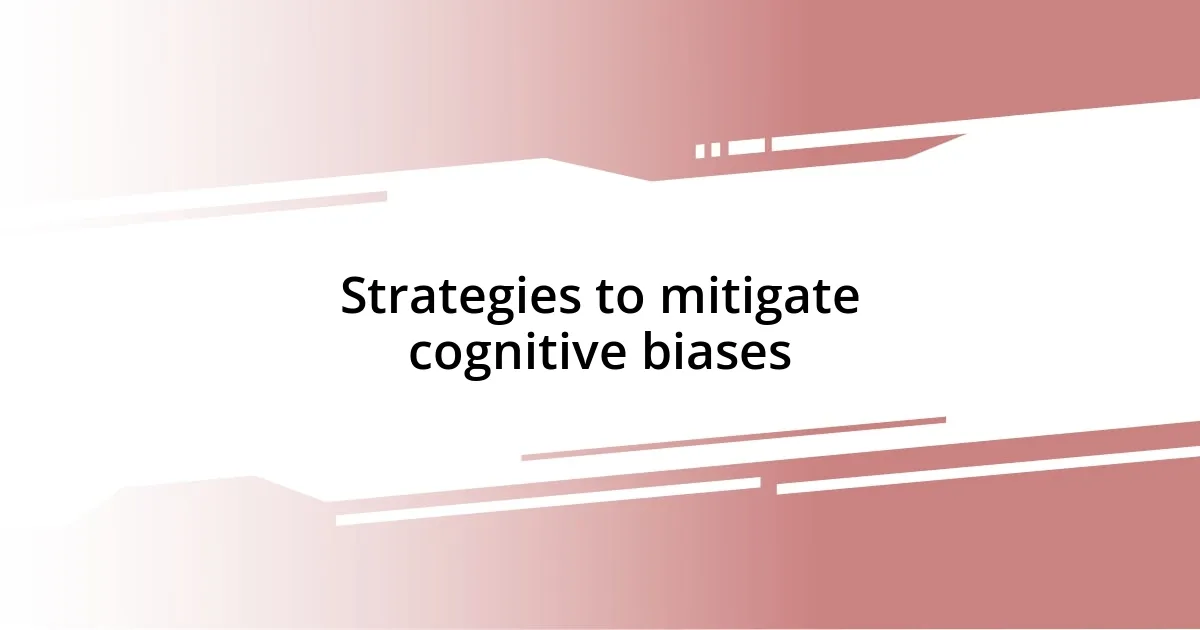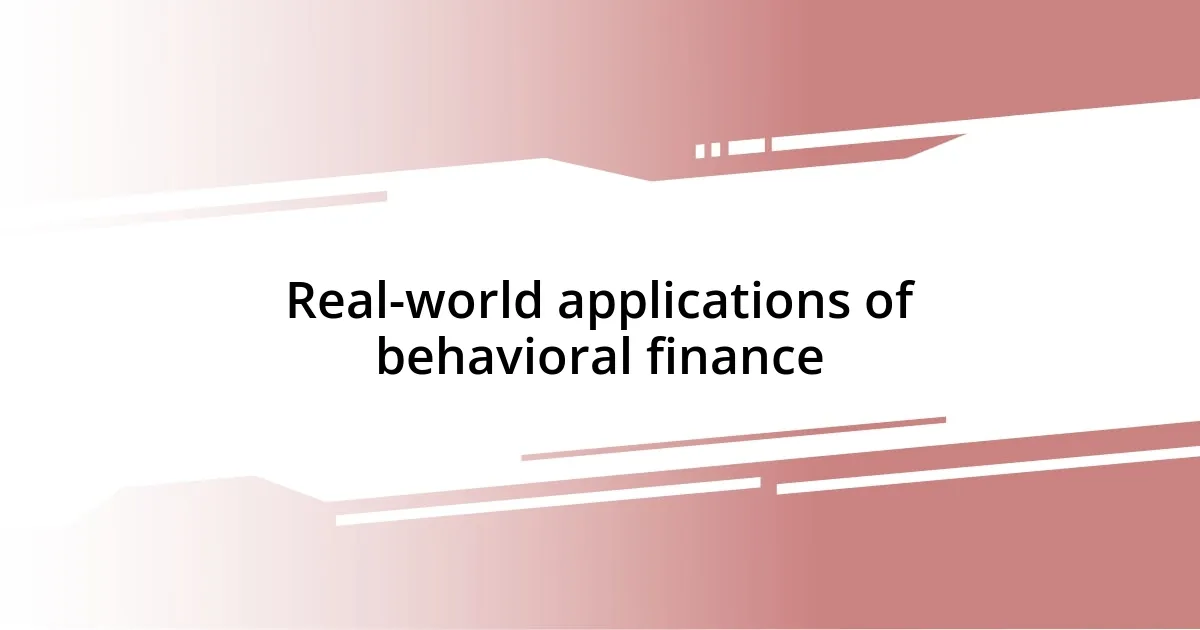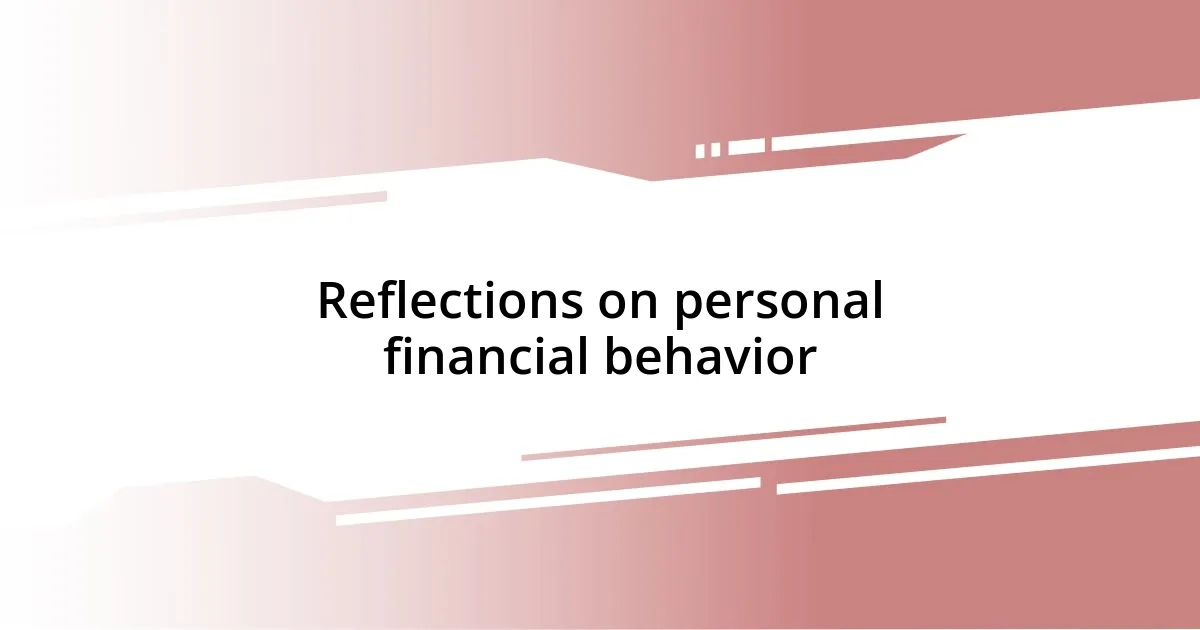Key takeaways:
- Behavioral finance concepts reveal how emotions and cognitive biases, like herd behavior and overconfidence, impact investment decisions.
- Key principles such as mental accounting, loss aversion, and anchoring bias significantly shape financial behavior and choices.
- Strategies like structured decision-making, seeking diverse perspectives, and educating oneself about behavioral finance can help mitigate cognitive biases.
- Recognizing the influence of behavioral finance in real-world scenarios, such as retirement planning and consumer behavior, enhances informed financial decision-making.

Understanding behavioral finance concepts
Understanding behavioral finance concepts involves delving into how our emotions and cognitive biases influence financial decisions. I remember a time when I impulsively bought a stock after hearing a friend rave about it. In hindsight, I realized that my excitement clouded my judgment, a classic example of herd behavior, where we tend to follow the crowd rather than relying on our analysis.
Another pivotal aspect of behavioral finance is overconfidence, which can lead to significant misjudgments. Just the other day, I spoke with a colleague who was certain of the success of a tech startup, ignoring all warning signs. It made me question: how often have I let my own confidence skew my investment choices? This notion resonates deeply; we often believe we know more than we actually do, which can be perilous.
Finally, loss aversion, the idea that we feel losses more intensely than gains, often shapes our financial behavior. I recall selling a stock that had plummeted, simply to avoid further losses, only to watch it rebound shortly after. Have you ever made a similar decision out of fear? It highlights how our emotions can dictate our actions, sometimes leading us astray.

Key principles of behavioral finance
One of the most intriguing principles of behavioral finance is mental accounting. This concept explains how we categorize money into different mental “buckets” based on subjective criteria. I once found myself treating a bonus from work as “free money,” spending it more frivolously than my regular salary. It’s fascinating how this tendency can distort our spending and savings behaviors, leading to less-than-optimal financial decisions.
Here are some key principles that illustrate the nuances of human behavior in finance:
- Herd Behavior: Following the crowd often clouds our judgment, leading to irrational investments.
- Overconfidence: We may overestimate our knowledge and abilities, risking poor decision-making.
- Loss Aversion: The fear of losses weighs more heavily on us than the pleasure of gains, often paralyzing our choices.
- Mental Accounting: We compartmentalize funds, which can skew our perception of value and lead to unwise spending.
- Anchoring: This principle shows how we rely too heavily on the first piece of information we encounter, affecting our financial choices.
Reflecting on these principles, I realize they truly shape how we navigate our financial journeys. They’re not just theoretical concepts; they’re practical insights into our everyday financial lives.

Common biases in financial decisions
I’ve found that common biases can significantly impact our financial decisions. One example is the anchoring bias, where we cling too tightly to the first piece of information we see, such as a stock’s initial price, even when market conditions change. There was a time I hesitated to sell a stock because I kept thinking about the high price I had initially paid. This fixation cost me potential gains. Could you relate to that feeling of hesitation? It’s like being trapped in our own mental bubble.
Another prevalent bias is confirmation bias, which leads us to favor information that supports our beliefs while disregarding contrary evidence. I remember doing lots of research on a particular investment and only focusing on articles that praised it while ignoring the skeptics. This selective perception felt so comforting, yet it masked the reality that could have helped me make a more informed decision. Have you ever found yourself in a similar situation?
Then there’s status quo bias, which keeps us stuck in our current financial habits or investments, even when better options may exist. I’ve stayed in underperforming funds simply because the thought of switching seemed overwhelming. It’s a comfort zone that can rob us of potential growth. Reflecting on these biases makes me realize how often they subtly steer our choices.
| Bias | Description |
|---|---|
| Anchoring Bias | Tendency to rely too heavily on the first piece of information encountered. |
| Confirmation Bias | Favoring information that confirms existing beliefs, ignoring contradictory evidence. |
| Status Quo Bias | The inclination to stick to current practices, avoiding change or new options. |

Impact of emotions on investing
When it comes to investing, emotions can be a double-edged sword. I remember a moment during a market dip when panic set in. My gut told me to sell everything, fearing deeper losses. It was a classic reaction to fear — one that almost made me miss a subsequent recovery. Have you ever felt that rush of anxiety about your investments? It’s amazing how emotions can lead us to make hasty decisions that aren’t in our best financial interests.
On the flip side, there’s also the thrill of excitement that comes with a rising stock. I’ve often found myself drawn into euphoria during a market upswing, feeling the urge to invest even more. However, I learned the hard way that chasing performance can lead to over-exposure in certain assets. Have you ever felt that high? It’s exhilarating at the moment, but it can lead to a reality check when the market turns. Recognizing this emotional pull is crucial for fostering a disciplined investing approach.
Navigating these emotional highs and lows requires self-awareness. I made it a point to pause and reflect on my feelings during significant investment decisions. Embracing a more analytical perspective has helped me avoid being swept away by emotions. This shift has led to more thoughtful strategies, but I still need to remind myself regularly – how do you manage your emotions when it comes to investing?

Strategies to mitigate cognitive biases
A great way to mitigate cognitive biases is by implementing a structured decision-making process. In my journey, I’ve found using a checklist before making any investment helped clear my mind of emotional clutter. It’s like having a safety net that ensures I consider all relevant factors rather than just my initial feelings. Have you ever tried a checklist? It can be surprisingly effective in bringing clarity to your decisions.
Another valuable strategy is to seek diverse perspectives. When I started discussing my investment ideas with friends who hold different viewpoints, I was often challenged to think beyond my biases. Hearing their insights forced me to reassess my opinions and ultimately led to more informed choices. Have you ever experienced that lightbulb moment after someone presented a different angle? It just goes to show that collaboration can be a powerful tool against bias.
Additionally, I’ve discovered that regularly educating myself about behavioral finance can be a game changer. By understanding the psychological factors that influence our choices, I’m better equipped to recognize my biases in real-time. For instance, I found that simply acknowledging the existence of confirmation bias helped me reconsider the information I consume. How often do you take a moment to reflect on what influences your financial decisions? Embracing that self-awareness has made a significant difference for me.

Real-world applications of behavioral finance
Seeing how behavioral finance plays out in real-world scenarios has been eye-opening for me. For example, I recall a friend who invested heavily in a popular tech stock solely because everyone else seemed to be doing it. Despite it being a crowded space, she ignored the fundamentals. Watching her ride the wave of market enthusiasm only to face massive losses later brought home the importance of independent research and skepticism. Have you ever found yourself swept up in a trend, only to question your choices later?
Another compelling application of behavioral finance is in retirement planning, where I have noticed that many people underestimate the power of compound interest. It’s fascinating how a simple choice to start early can significantly alter financial futures. I remember sitting down with a colleague who was skeptical about investing in her 401(k), thinking she could catch up later. After showing her projections of potential growth, seeing her face light up with understanding was priceless. Have you considered how small, consistent contributions can lead to exponential growth over time?
Lastly, I’ve become increasingly aware of how behavioral finance influences marketing strategies. Companies often leverage psychological triggers to appeal to consumer emotions, and I’ve found myself falling for this inadvertently. I think back to a recent shopping spree where I was drawn in by scarcity marketing—limited-time offers and exclusive deals. It prompted me to buy things I’d hardly use. Have you ever made a purchase that you later regretted due to impulsive thinking? Recognizing these tactics helps me be a more conscious consumer, cultivating a mindset that prioritizes long-term satisfaction over short-term thrills.

Reflections on personal financial behavior
I often reflect on my own spending habits and how emotional triggers can lead to impulsive decisions. There was a moment when I walked into a store, and the glittering sale signs mesmerized me. It wasn’t until I got home and realized I had purchased items I didn’t need that I understood the impact of this emotional high. Have you ever experienced buyer’s remorse right after an impulsive purchase?
When it comes to my savings, I’ve noticed how easily I can fall into the trap of overconfidence. I once thought I could wait until the end of the month to invest, believing I had plenty of time. But each month, life seemed to get busier, and that opportunity slipped away. This taught me the importance of setting specific, actionable savings goals instead of leaving them to chance. How do you prioritize saving in your busy life?
A profound realization for me has been the significance of small changes in my financial behavior. I experimented with rounding up my purchases to the nearest dollar and transferring the spare change to savings. Surprisingly, those little amounts added up quickly and became a valuable cushion. It’s a gentle reminder that tiny steps can lead to significant changes. Have you considered how small adjustments in your daily spending could transform your financial habits?














